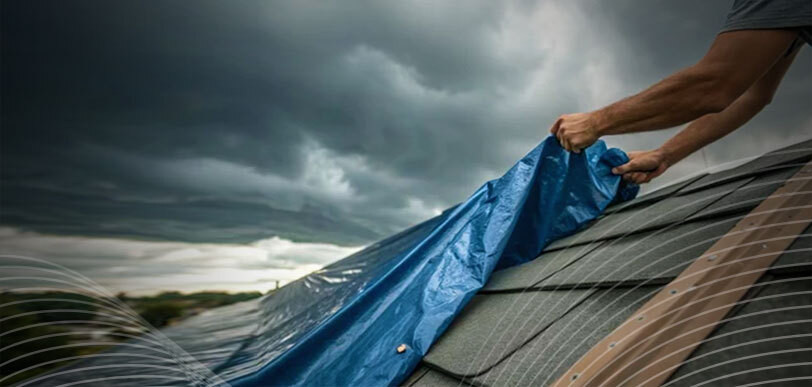When storms hit, the fastest way to stop leaks is often a temporary tarp — and it all starts with accurate measurements. Below is a practical guide to measuring a roof for tarping, choosing the right tarp size, and securing it safely. You’ll also see how RoofScope reports help you get remote roof measurements you can trust for tarping, estimating, and material orders.
Safety first
- Wait for dry, calm weather and use proper PPE (non-slip boots, gloves, eye protection).
- Inspect from a ladder whenever possible; avoid walking on wet or steep roofs.
- Clear loose debris (branches, leaves) before you measure.
How to measure the roof area for tarping
Measure the damaged section and then add overlap for secure anchoring. A common rule of thumb is to add 3–4 extra feet on every side or use the simple 1.5× sizing guideline below.
Roof tarp sizing calculator (1.5× rule)
Many pros size the tarp at about 1.5× the measured roof area to allow for ridgeline coverage and wrap/anchoring.
Choosing the right tarp
- Material: Heavy-duty, waterproof, UV-resistant tarps last longer.
- Size: Ensure coverage extends past the ridgeline on sloped roofs.
- Duration: Standard heavy-duty tarps work for short-term (often up to ~90 days). For longer coverage, consider thicker tarps (e.g., ~10-mil).
How to secure the tarp
- Position: Center the tarp over the damaged area; extend 3–4 ft beyond all edges and over the ridge on sloped roofs.
- Anchor boards (most secure): Roll the tarp edge around a 2×4, then screw through the board/tarp into the roof deck. Repeat around edges to keep the tarp taut.
- Sandbags (temporary): Weigh down edges where fasteners aren’t practical for a short-term hold.
Never stand on a tarp — it’s slippery, especially when wet.
Measure once, tarp fast: how RoofScope helps
Need measurements without climbing a ladder? RoofScope delivers remote roof measurement reports you can rely on. Use them to:
- Size tarps accurately for emergency coverage (full roof or specific facets).
- Estimate the roofing project with square footage, pitch, and linear measurements already documented.
- Create material orders for shingles, underlayment, drip edge, and more — all from the same measurement set.
Because RoofScope reports are produced by CAD technicians, you get consistent, high-accuracy data that shortens the time from inspection to installation.
FAQs
What’s the fastest way to figure tarp size?
Measure the affected area and multiply by ~1.5 for total coverage. Round up to common tarp sizes and ensure it crosses the ridgeline on sloped roofs.
How much extra should I add when measuring a roof for tarping?
Plan for at least 3–4 feet of overhang on every side to wrap and secure the edges, or use the 1.5× rule.
Can I measure remotely?
Yes. RoofScope measurement reports provide accurate roof dimensions remotely, which you can use for tarping measurements, full roofing estimates, and material orders once you move from temporary protection to replacement.
How long can a tarp stay on a roof?
Tarps are a temporary solution. Many pros aim for repair or replacement within ~90 days, sooner if possible.
Need precise measurements without a site visit?
Order a RoofScope report to size your tarp accurately today — and reuse the same data for project estimating and material orders.
written by RoofScope published on 08. 12. 2025

